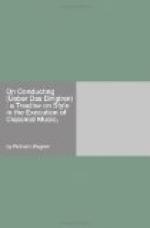To convey some notion of faulty performances of the latter sort it will suffice to point to the way in which the overture to “Die Meistersinger” is usually given. The main tempo of this piece is indicated as “sehr massig bewegt” (with very moderate movement); according to the older method, it would have been marked Allegro maestoso. Now, when this kind of tempo continues through a long piece, particularly if the themes are treated episodically, it demands modification as much as, or even more than any other kind of tempo; it is frequently chosen to embody the manifold combinations of distinct motives; and its broad divisions into regular bars of four beats are found convenient, as these tend to render modifications of movement both easy and simple. This moderate 4/4 time can be interpreted in many and various ways; it may consist of four vigorous crotchet-beats, and thus express a true animated Allegro (this is the main tempo I intend, which becomes most animated in those eight bars of transition
[2 measures of music are shown here]
which lead from the march proper to the theme in E major); or, it may be taken to consist of a demi-period made up of two 2/4 beats; as when, at the entrance of the shortened theme,
[2 measures of music are shown here]
it assumes the character of a lively Scherzando; or, it may even be interpreted as Alia breve (2/2 time) when it would represent the older, easily moving Tempo andante (often employed in church music) which is to be rendered with two moderately slow beats to a bar. I have used it in the latter sense, beginning from the eighth bar after the return to C major, in a combination of the principal march theme, now allotted to the basses, with the second main theme, now sung broadly and with commodious ease, in rhythmical prolongation, by the violins and violoncellos:
[Three measures of music are shown here]
This second theme has previously been introduced in diminution, and in common 4/4 time:
[Two measures of music are shown here]
Together with the greatest delicacy which the proper execution demands, it here exhibits a passionate, almost hasty character (something like a whispered declaration of love). Not to disturb the main characteristic, delicacy, it is, therefore, necessary slightly to hold back the tempo (the moving figuration sufficiently expresses passionate haste), thus the extreme nuance of the main tempo, in the direction of a somewhat grave 4/4 time, should be adopted here, and, to do this without a wrench (i.e., without really disfiguring the general character of the main tempo), a bar is marked poco rallentando, to introduce the change. Through the more restless nuance of this theme:
[A musical score]
which, eventually, gets the upper hand, and which is indicated with “leidenschaftlicher” (more passionate) it is easy to lead the tempo back into the original quicker movement, in which, finally, it will be found capable to serve in the above-mentioned sense of an Andante alla breve, whereby it is only needful to recur to a nuance of the main tempo, which has already been developed in the exposition of the piece; namely, I have allowed the final development of the pompous march theme to expand to a lengthy coda of a cantabile character conceived in that tempo Andante alia breve. As this full-toned cantabile




